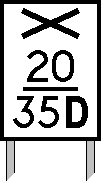|
|
|
|
|
|
Some user-worked level crossings have been provided with markers that help engineering staff to check that sighting distances for crossing users have not been compromised by vegetation growth. They are installed in either direction from the crossing at the required sighting distance and have no relevance to train drivers. The sighting markers on the Scotland Zone, which were installed from 1996, take the form of tall yellow rectangular boards that face towards the crossing [16.34]. These are provided in pairs, with one marker being placed on each side of the line. On lines in South Wales (Great Western Zone), a single orange post is provided on the approach to the level crossing, in each direction [16.35].
 |
 |
|
[16.34] Level Crossing Sighting Marker Board.
Area: Scotland Zone Usage: Medium Status: Uncertain |
[16.35] Level Crossing Sighting Marker Post.

Area: South Wales Usage: High Status: Uncertain |
|---|
|
Four level crossings on the Braintree and Sudbury lines (East Anglia Zone) were converted to ABCL type in May 1997. The same method of presenting non-standard differential speed restrictions on the railways in this area using a single-letter suffix (see [13.79 & 13.80]) was employed on the special speed restriction boards associated with these level crossings [16.36]. |
|
From 1998, experimental notice boards were provided on the rail approaches to certain user-worked level crossings in the Scotland Zone. These show the name and mileage of the crossing concerned [16.37].
In 2000, level crossing identification plates were fitted at user-worked level crossings with telephones on the Cambrian Lines (Midlands Zone). The signs display a unique level crossing number [16.38] which may be used in telephone communications to identify a particular crossing, avoiding any difficulties that might arise in pronouncing its Welsh name.
 |
 |
[16.37] Level Crossing Identification Sign.

Area: Scotland Zone Usage: High Status: Current |
[16.38] Level Crossing Identification Plate.
Area: Cambrian Lines Usage: High Status: Current |
|---|
In 2003, a new design of combined speed restriction/whistle board was introduced, for use at Open crossings. Unlike the former design (see [16.22 & 16.23]), the speed figures are in black characters on a white background [16.39 & 16.40]. This change brought these signs into conformity with other speed restriction signs that have black characters for speeds given in miles per hour, the black background now being reserved for metric signs (see Section 13).
 |
 |
|
[16.39] Combined Speed Restriction/Whistle Board.
Area: All Areas Usage: Low Status: Current |
[16.40] Combined Speed Restriction/Whistle Board (differential speed restriction).
Area: All Areas Usage: Low Status: Current |
|---|
Also in 2003, the design of the special speed restriction boards for locally monitored level crossings was altered, the wide St. Andrew's cross at the top (see [16.28 & 16.29]) being replaced by a narrower version [16.41 & 16.42].
 |
 |
|
[16.41] Speed Restriction Sign for a Locally Monitored Crossing.
Area: All Areas Usage: High Status: Current |
[16.42] Differential Speed Restriction Sign for a Locally Monitored Crossing.
Area: All Areas Usage: High Status: Current |
|---|
|
Locally monitored level crossings (AOCL or ABCL) on lines with ETCS cab signalling are provided with all the usual lineside signs and indicators except that the crossing speed restriction signs (see [16.41 & 16.42]) are replaced by 'sighting boards', with just a black cross on a white background [16.43]. When the train reaches this board, the driver must check that the driver's white light is flashing (see [16.15]) and that the crossing is not obstructed, in which case the train may proceed towards the crossing at the speed indicated on the driver's cab display. |
|
|
The wrong-direction movement speed restriction sign for an automatic level crossing (see [16.31]) has a metric equivalent with the figures (representing the permissible speed in kilometres per hour) in white characters on a black background [16.44]. |
|
Various alternative styles of sighting markers have been installed at user-worked, bridleway and footpath crossings, each facing towards the relevant level crossing. The new sighting markers provided on the Western Route from early 2014 comprise a white post with a yellow reflectorised strip on the side facing the level crossing [16.45]. Around the same time, sighting markers appeared on the Sussex Route bearing the informative, if somewhat long-winded, description "level crossing off track vegetation cutback sighting marker" in red text on a square blue background [16.46]. On the London North Western Route, the sighting marker boards are in the form of a solid yellow triangle [16.47], while those on the Great Eastern Main Line comprise a tall yellow board with the legend "level crossing" at the top and the word "sighting" below, with the letters arranged vertically [16.48]. The sighting markers on the Isle of Wight are the same style as those used in the Republic of Ireland, consisting of a white circular board with a black letter "V" (for "vegetation") [16.49].
 |
 |
 |
|
[16.45] Level Crossing Sighting Marker Post.
Area: Western Route Usage: High Status: Current |
[16.46] Level Crossing Sighting Marker Board.
Area: Sussex Route Usage: Medium Status: Current |
[16.47] Level Crossing Sighting Marker Board.
Area: LNW Route Usage: Low Status: Current |
|---|
 |
 |
|
[16.48] Level Crossing Sighting Marker Board.
Area: Great Eastern Main Line Usage: Medium Status: Current |
[16.49] Level Crossing Sighting Marker Board.
Area: Isle of Wight Usage: Low Status: Current |
|---|
|
|